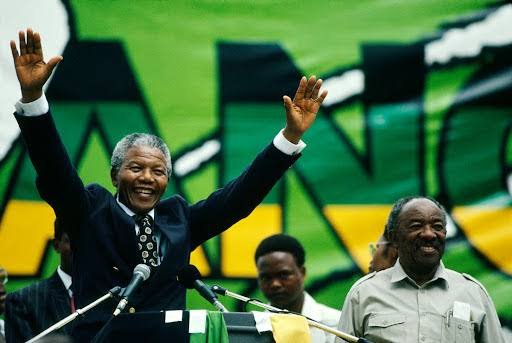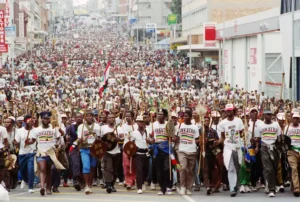Have you ever wondered how a nation can undergo a radical transformation from a system of racial segregation to a thriving democracy? The end of apartheid in South Africa in 1994 marks one of the most significant turning points in modern history. It’s a story of struggle, resilience, and an unwavering quest for justice. Let's go into the captivating tale of how apartheid ended, the key figures involved, and the lasting impact on South Africa and the world.
The Roots of Apartheid
To understand the end of apartheid in South Africa in 1994, we need to start at the beginning. Apartheid, which means "apartness" in Afrikaans, was a system of institutionalized racial segregation that started in 1948 when the National Party came to power. The government enforced policies that discriminated against non-white citizens, stripping them of their rights and freedoms. Imagine living in a country where your skin color dictated where you could live, work, and even who you could marry. This was the harsh reality for millions of South Africans.
The Segregation Policies
The apartheid regime introduced a series of laws to enforce segregation:
- Population Registration Act (1950): Classified all South Africans by race.
- Group Areas Act (1950): Segregated residential areas by race.
- Pass Laws: Required non-whites to carry passbooks to move around.
- Bantu Education Act (1953): Provided inferior education for black South Africans.
These laws created a society where whites held all the power, and non-whites were oppressed and marginalized.
The Rise of Resistance
No oppressive system can survive without resistance, and the end of apartheid in South Africa was fueled by courageous individuals and movements who fought tirelessly for freedom and equality.
Nelson Mandela and the ANC

Nelson Mandela is a name synonymous with the fight against apartheid. As a leader of the African National Congress (ANC), Mandela advocated for peaceful protests, but when the government responded with violence, he endorsed armed struggle. This decision led to his arrest and imprisonment in 1962. Mandela's imprisonment turned him into a global symbol of resistance, and his release in 1990 marked the beginning of the end for apartheid.
The Soweto Uprising
In 1976, students in the township of Soweto protested against the Bantu Education system. The government’s brutal response, which included shooting unarmed students, sparked international outrage. The images of children being gunned down were broadcast worldwide, highlighting the cruelty of the apartheid regime.
International Pressure
The global community played a crucial role in ending apartheid. Economic sanctions, cultural boycotts, and diplomatic pressure isolated South Africa. Countries around the world cut ties, and multinational corporations withdrew their investments. It became clear that apartheid was not only morally indefensible but also economically unsustainable.
The Path to Negotiation
The road to the end of apartheid in South Africa in 1994 was paved with negotiations and political maneuvering. By the late 1980s, it was evident that the system could not endure much longer.
De Klerk’s Reforms
In 1989, F.W. de Klerk became the President of South Africa. Recognizing the need for change, he initiated a series of reforms, including the unbanning of political parties like the ANC and the release of political prisoners, including Nelson Mandela. These actions set the stage for meaningful negotiations.
The Convention for a Democratic South Africa (CODESA)
In 1991, multi-party negotiations began at the Convention for a Democratic South Africa (CODESA). These talks aimed to dismantle apartheid and establish a democratic government. Despite setbacks and violence, the negotiations continued, reflecting the determination of all parties to achieve a peaceful transition.
The 1994 Elections
The culmination of these efforts was the historic election in April 1994. For the first time, all South Africans, regardless of race, were allowed to vote. The ANC won a sweeping victory, and Nelson Mandela was elected as the first black President of South Africa. This election symbolized the end of apartheid and the birth of a new, democratic nation.
Key Places in the Apartheid Struggle
Let's take a virtual tour of some of the significant locations that played a pivotal role in the end of apartheid in South Africa in 1994.
Robben Island
Robben Island, located off the coast of Cape Town, is where Nelson Mandela spent 18 of his 27 years in prison. Today, it stands as a UNESCO World Heritage Site and a powerful symbol of the resilience of the human spirit.
Soweto
Soweto, a township near Johannesburg, was the epicenter of the 1976 uprising. The Hector Pieterson Memorial and Museum in Soweto commemorate the students who lost their lives fighting for their rights.
Cape Town
Cape Town, one of South Africa’s legislative capitals, was the site of many significant events, including Mandela's release from Victor Verster Prison. The city is also home to Parliament, where apartheid laws were once crafted and where democracy was later restored.
Sharpeville
The town of Sharpeville gained international attention after the Sharpeville Massacre in 1960, where police opened fire on peaceful protestors, killing 69 people. This tragic event highlighted the brutality of the apartheid regime and galvanized resistance movements.
Life After Apartheid
The end of apartheid in South Africa in 1994 was a momentous occasion, but it also marked the beginning of a new set of challenges. Building a united and equitable society after decades of division was no small feat.
Truth and Reconciliation Commission (TRC)
To address the injustices of the past, the Truth and Reconciliation Commission (TRC) was established in 1995. Led by Archbishop Desmond Tutu, the TRC provided a platform for victims to share their experiences and for perpetrators to confess their crimes. This process aimed to heal the nation and promote reconciliation.
Economic Disparities
Despite the political victory, economic disparities remain a significant issue in South Africa. The legacy of apartheid left a deep economic divide, with many black South Africans still living in poverty. Efforts to redress these inequalities, such as land reform and affirmative action, are ongoing but complex.
Social Integration
Social integration has been another critical challenge. While apartheid laws were abolished, overcoming deeply ingrained prejudices and fostering unity takes time. Initiatives to promote multiculturalism and equal opportunity in education and employment are vital for building a cohesive society.
Conclusion
The end of apartheid in South Africa in 1994 is a testament to the power of resilience, unity, and the unwavering quest for justice. The journey from a divided society to a democratic nation was fraught with challenges, but it also showcased the strength and courage of countless individuals. As South Africa continues to navigate its path towards equality and unity, the legacy of those who fought for freedom remains an enduring source of inspiration.
Frequently Asked Questions
Q: What was apartheid in South Africa?
A: Apartheid was a system of institutionalized racial segregation and discrimination in South Africa that existed from 1948 until the early 1990s. It enforced severe restrictions on the rights of non-white citizens and created a highly stratified society.
Q: Who played a significant role in ending apartheid?
A: Nelson Mandela, the African National Congress (ANC), F.W. de Klerk, and numerous activists and international supporters played crucial roles in ending apartheid.
Q: What were the key events leading to the end of apartheid?
A: Significant events include the Soweto Uprising (1976), the unbanning of the ANC (1990), Nelson Mandela’s release from prison (1990), and the first democratic elections in 1994.
Q: How did the international community influence the end of apartheid?
A: The international community exerted pressure through economic sanctions, cultural boycotts, and diplomatic efforts, which isolated South Africa and highlighted the moral and economic unsustainability of apartheid.
Q: What is the significance of the 1994 elections in South Africa?
A: The 1994 elections were the first in which all South Africans, regardless of race, could vote. This election marked the official end of apartheid and the beginning of a democratic South Africa.


